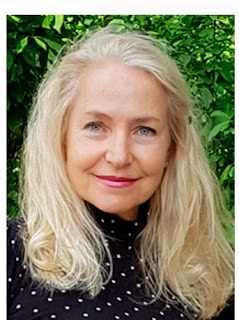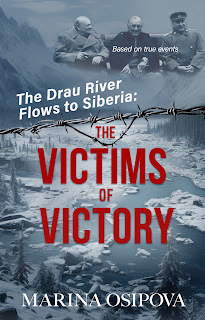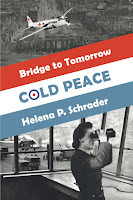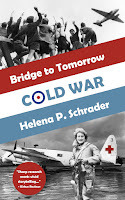Why I Write Historical Fiction - A Guest Blogpost by Marina Ospova
Marina Osipova is a multi-award-winning and a best-sellingauthor who writes with “emotional realism” and “taking on a subject that fewauthors have touched.” A graduate from the Moscow State Institute of Historyand Archives, she is dedicated to writing historical fiction, especiallyrelated to WWII and the Eastern front.

I wasn’t born a story-teller. If twenty yearsago somebody would tell me I’ll become a writer and by now will have sixpublished books under my belt, I’d thought this person . . . fill the dots. Idon’t know what bug had bitten me, but after my immigration to the United States,I started writing. So, it must have been an American bug. First, there wereflash stories, then short stories, then a contemporary tale of my life in theSoviet Union during Perestroika, which, to my total astonishment, garnered someliterary awards. When I was close to finishing the next contemporary romance,something happened: an insistent vision of a simple grave on the outskirts of avillage 100 miles away from Moscow where my parents bought a peasant hut tospend summers would invade my mind. The grave was of eight local men who wereshot and killed by the invading Germans in 1941. Repeatedly, this imagedistracted me from my work in progress; it squeezed all ideas that were tobring me to the desired fruition of my book in progress out of my head. Soon itbecame an obsession. The Cruel Romance wasconceived. I think it was the first piece in my writing-related jigsaw puzzle.
I was born to a military family and, more tothat, it took place in a military hospital thirty miles away from Berlin in theEastern Germany. I consider it to be one of the keys to thepuzzle.
Raised up in the then Soviet Union,inevitably, like every child since kindergarten, I was educated as belonging toa glorious nation, the one that came victorious in the Great Patriotic War asWWII was and still is called in modern Russia and on the post-Soviet territories. We grewup surrounded by portraits of the Communist Party leaders and war heroes, be ita general or a soldier.
The cult of war manifested itself everywhere.In my school, walls were decorated with nine portraits of its graduates—theHeroes of the Soviet Union (the highest distinction in the USSR). Of course, weknew their biographies by heart; we visited their parents or family members whoshowed us their pictures and tearfully but proudly told us stories about theirperished loved ones. That was another important key.
We were brought up in an unshakable belief in“the heroic feat of the Soviet people, who saved humanityfrom the fascist plague.” In any school throughout the country, in historylessons and at special events, the concept about the war and the liberatingmission of the Soviet people was embedded into the immature consciousness ofpupils’ heads.
Books and movies about war—there werethousands of them! The war songs! We, children, and teenagers, sang them whilemarching along streets in columns during holidays, at the Young Pioneersgatherings and Komsomol meetings, adults at the table with a vodka bottle whilecoming together for whatever reason. The Katyusha song! Whodoesn’t know it? The entire world knows!
In middle-school classes, we were trained tohandle a grenade and a rifle, and, of course, how to pull up a gas maskquickly. I loved to go to a shooting range: in my brain, the idea of beingprepared to “defend my country from the damned western capitalists and imperialists”took deep roots. In winter, we had “war-games” where we used snowballs forbullets and an opposing party was the enemy—another way to anchoring the ideaof an imminent war in our immature consciousness.
Every year, Victory Day parades on the RedSquare on 9 May—who didn’t see them on the news?
Every place, small and big, had its warmuseum, even if it was a tiny room or a corner of the classroom. Nowadays, it hasbecome popular again! Travel around Russia, and you’ll see a T34, cannons, theKatyusha rocket launchers on pedestals in cities, villages, and alongroadsides. As if calling: “Never forget it!”
As I’ve already mentioned, my father was inthe active military. He was a child during the war, but his older brothersfought on the front, and the youngest of them perished at eighteen. He waspronounced missing. The family learned of the place where he perished and wasburied only after the Soviet Union collapsed. There were no conversations aboutwar experiences in the family. Many years ago, and it was only one time, one ofmy fathers’ brothers, while visiting us, told me embarrassingly about what theSoviet Army committed in Poland when it penetrated the country on itsavalanche-like forced march toward the Hitler Germany. Don’t ask me what hedivulged. I won’t tell you even under torture. It was a shock: the firstsobering key.
After Perestroika, when archives were opened(they were quickly sealed again) tons of literary works and makeshiftpublications previously banned splashed out onto the streets and to themarkets, freely changed hands. And what dreadful surprises they carried! Aboutevery aspect of our life. About the war. About the country’s leaders. The entirepopulation read themavidly. Me included. And what an appalling revelation it was! In my desire toget to the truth, but still under the spell of the insidious propaganda,I hesitantly started digging deeper. Inevitably, the accumulated newly gainedevidence about the war became that tipping point that allowed me to piecetogether all my personal experiences and the recent disclosures about the war.What didn’t change my mind, though, was and still is that the ordinary Sovietpeople sincerely defended their country without sparing their lives.
As I completed the jigsawpuzzle, it made me a historical fiction writer. I desperately want more peopleto learn about WWII from the perspective of the Soviet side and the Easternfront.
So, why do I writehistorical fiction? How could I not? It was destined.

Find out more about The Victims of Victory here.
Blog host Helena P. Schrader is an award-winning novelist and author of six non-fiction and twenty historical fiction books. Her current project in a three-part series about the Berlin Airlift.
The first two volumes of the Bridge to Tomorrow Trilogy are now available.

The first battle of the Cold War is about to begin....
Berlin 1948. In the ruins ofHitler’s capital, former RAF officers, a woman pilot, and the victim of Russianbrutality form an air ambulance company. But the West is on a collision coursewith Stalin’s aggression and Berlin is about to become a flashpoint. World WarThree is only a misstep away. Buy Now
Berlin is under siege. More than twomillion civilians must be supplied by air -- or surrender to Stalin's oppression.
USAF Captain J.B. Baronowsky and RAF FlightLieutenant Kit Moran once risked their lives to drop high explosives on Berlin.They are about to deliver milk, flour and children’s shoes instead. Meanwhile,two women pilots are flying an air ambulance that carries malnourished andabandoned children to freedom in the West. Until General Winter deploys on theside of Russia. Buy now!
Based on historical events, award-winning and best-selling novelistHelena P. Schrader delivers an insightful, exciting and moving tale about howformer enemies became friends in the face of Russian aggression — and how closethe Berlin Airlift came to failing.
Winning a war with milk, coal and candy!



